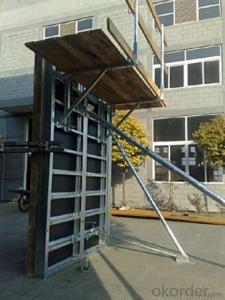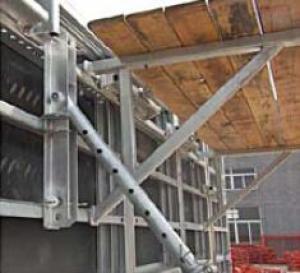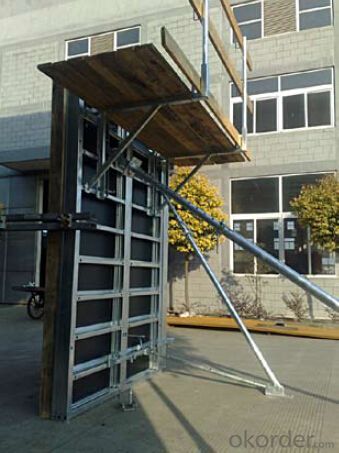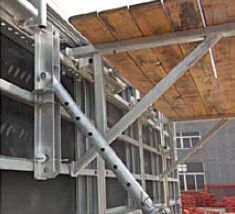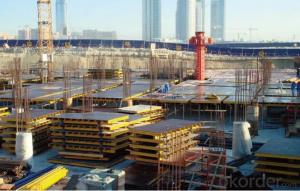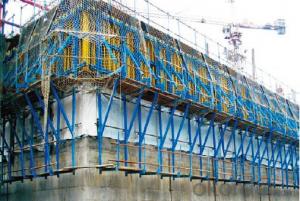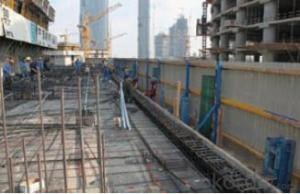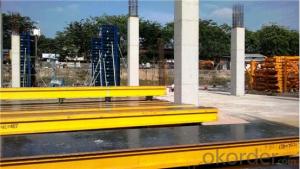Steel-Frame Working Platformfor Formwork and Scaffolding system
- Loading Port:
- Tianjin
- Payment Terms:
- TT OR LC
- Min Order Qty:
- 50 m²
- Supply Capability:
- 1000 m²/month
OKorder Service Pledge
OKorder Financial Service
You Might Also Like
Steel-frame Formwork SF-140
Characteristics:
◆ Few parts for fast forming.
◆ Max. Concrete pressure: 80KN/m2.
◆ Hot-dip galvanized steel frame.
◆ The thickness of plywood is 18mm & the panel is 14cm.
◆ Compatibility with Hunnebeck Manto system due to similar edge profile.
System Details & Application:
◆ Neat joint and fast assembling with aligning panel clamp.
◆ Flexible panel arrangement and height extension.
◆ The selection of panels.
◆ Kinds of panel connectors.
◆ Corner clamp application.
◆ Length adjustment application.
◆ Height adjustment & aligning strut.
◆ Walkway bracket & platform.
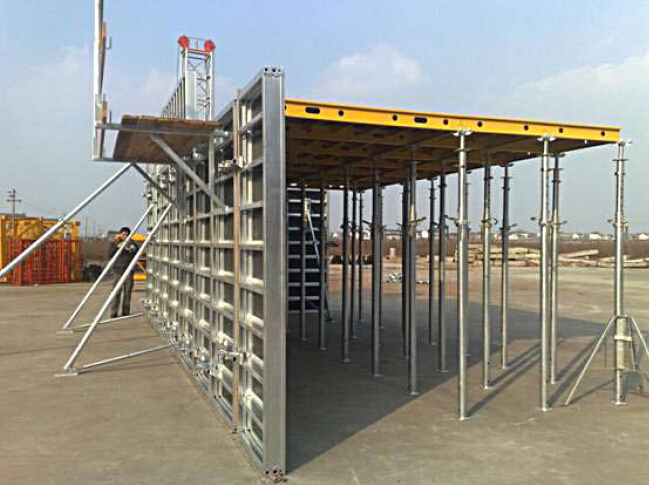

- Q: What are the typical safety precautions when working with steel formwork?
- When working with steel formwork, some typical safety precautions include wearing appropriate personal protective equipment (PPE) such as gloves, safety glasses, and steel-toed boots to protect against potential hazards. Additionally, workers should receive proper training on the proper handling and installation techniques of steel formwork systems. It is essential to ensure that the formwork is securely supported and adequately braced to prevent collapse or accidents. Regular inspection of the formwork for any damages or defects is also crucial to maintain a safe working environment.
- Q: Can steel formwork be used for bridge construction projects?
- Yes, steel formwork can be used for bridge construction projects. Steel formwork is a versatile and durable solution that is often preferred for bridge construction due to its high strength and load-bearing capacity. It provides a sturdy framework that can withstand the weight and pressure exerted by concrete during the construction process. Steel formwork offers several advantages for bridge construction projects. Firstly, it can be easily customized and fabricated to the desired shape and size, allowing for precise and efficient construction. Additionally, steel formwork can be reused multiple times, making it a cost-effective option for bridge construction projects. Furthermore, the use of steel formwork ensures a smooth and uniform finish on the bridge structure, resulting in a high-quality end product. Steel formwork also allows for the integration of various features, such as recesses and openings, which can be essential for bridge construction. Overall, steel formwork is a suitable choice for bridge construction projects due to its strength, durability, and ability to provide a precise and uniform finish.
- Q: Can steel formwork be used in areas with limited construction access roads?
- Yes, steel formwork can be used in areas with limited construction access roads. Unlike traditional formwork made of wood or other materials, steel formwork is durable, lightweight, and can be easily transported to remote locations. It can be disassembled and reassembled multiple times, making it suitable for areas with limited access roads where transportation of heavy construction materials is challenging. Additionally, steel formwork offers high strength and stability, ensuring the structural integrity of the construction even in difficult-to-reach areas.
- Q: How does steel formwork handle concrete bleeding?
- Steel formwork handles concrete bleeding by providing a strong and rigid structure that prevents excessive flow of water and cement particles from the concrete mixture. The smooth surface of steel formwork also helps in reducing the bleeding by allowing the trapped air and excess water to escape easily. Overall, steel formwork ensures better control over concrete bleeding and helps in achieving a more uniform and compacted concrete structure.
- Q: How does steel formwork affect the overall acoustics of the building?
- Steel formwork can have a significant impact on the overall acoustics of a building. Due to its dense and rigid nature, steel formwork tends to reflect sound waves instead of absorbing them. This reflection can cause an increase in overall noise levels and create echoes within the building. The use of steel formwork can result in a higher reverberation time, which is the time it takes for sound to decay by 60 decibels. This can lead to poor speech intelligibility and reduced clarity of audio within the space. Additionally, the sound reflections from steel formwork can interfere with the natural acoustic properties of the room, potentially causing distortion and resonance issues. To address these challenges, sound-absorbing materials can be added to the interior surfaces of the building. This can help to reduce the reflection and reverberation of sound waves, improving the overall acoustics of the space. Options include the use of acoustic panels, insulation materials, and ceiling treatments that absorb and diffuse sound. It is important to consider the specific requirements of the building and its intended use when deciding on the type of formwork to be used. For spaces where good acoustics are crucial, such as auditoriums, concert halls, or recording studios, alternative formwork materials that provide better sound absorption properties may be preferred over steel formwork. However, in other applications where acoustics are less critical, steel formwork can still be used effectively with the addition of appropriate sound-absorbing measures. Overall, the choice of steel formwork can have a significant impact on the acoustics of a building. Proper consideration of sound absorption and reflection properties, along with the use of additional acoustic treatments, can help to mitigate any negative effects and create a more pleasant and functional acoustic environment.
- Q: How does steel formwork contribute to the strength and stability of a concrete structure?
- Steel formwork is a critical component in the construction of concrete structures as it plays a crucial role in enhancing their strength and stability. One of the key ways in which steel formwork contributes to this is by providing a robust framework for the concrete to be poured into and cured. The steel formwork acts as a mold or a template that holds the liquid concrete in place until it solidifies. This ensures that the concrete takes the desired shape and form, resulting in a structurally sound and stable structure. Furthermore, steel formwork provides support and reinforcement to the concrete during the curing process. As the concrete hardens, it exerts pressure on the formwork. The high tensile strength of steel allows it to withstand and distribute these forces evenly, thereby preventing any distortion or collapse of the structure. This is particularly important in the case of large-scale or complex structures where the concrete needs to be supported over extended periods. In addition, steel formwork facilitates the proper alignment and leveling of the concrete during the construction process. The rigid nature of steel ensures that the formwork remains in place and maintains its shape, resulting in accurate dimensions and a uniform finish. This contributes to the overall strength and stability of the concrete structure by eliminating any irregularities or weaknesses that may arise from inaccuracies in the formwork. Moreover, steel formwork can be easily assembled and disassembled, allowing for efficient construction processes. This flexibility enables faster construction timelines, minimizing the exposure of the concrete to external elements and reducing the risk of structural damage. The ability to reuse steel formwork also makes it a cost-effective solution for multiple construction projects. Overall, the use of steel formwork significantly enhances the strength and stability of concrete structures by providing a sturdy framework, supporting the curing process, ensuring accurate alignment, and facilitating efficient construction practices. Its durability, strength, and versatility make it an essential component in the construction industry, contributing to the creation of safe and reliable concrete structures.
- Q: How does steel formwork handle concrete curing?
- Steel formwork is widely chosen for concrete construction because of its durability and strength. When it comes to concrete curing, steel formwork offers several advantages. First and foremost, steel formwork ensures excellent support and stability for the concrete during the curing process. With its rigid structure, it guarantees that the concrete maintains its desired shape and form, preventing any deformations or bulges. This is especially important for projects that require precise dimensions or intricate designs. Secondly, steel formwork has good heat conductivity, enabling efficient heat dissipation during concrete curing. This is beneficial as it helps regulate the concrete's temperature, preventing excessive heat buildup that could result in cracks or other structural issues. Steel's ability to dissipate heat quickly also accelerates the curing process, reducing the overall time required for the concrete to achieve its desired strength. Moreover, steel formwork can withstand the high pressures exerted by the wet concrete during the curing phase. Its robust nature ensures that it remains intact and doesn't deform or buckle under the weight of the concrete, maintaining its structural integrity throughout the process. Additionally, steel formwork is reusable, making it a cost-effective option for concrete curing. Once the concrete has cured and hardened adequately, the formwork can be easily removed, cleaned, and reused for future projects. This eliminates the need for frequent formwork replacements and reduces construction waste. In conclusion, steel formwork is an ideal choice for concrete curing due to its stability, heat conductivity, strength, and reusability. It provides excellent support, regulates temperature, withstands high pressures, and offers cost savings. These characteristics make steel formwork a reliable and efficient option for ensuring successful concrete curing in construction projects.
- Q: What are the different types of steel formwork systems?
- There are several different types of steel formwork systems commonly used in construction projects. These systems are designed to provide a temporary mold or structure to support the concrete during the pouring and curing process. Here are some of the different types of steel formwork systems: 1. Traditional steel formwork: This is the most common type of steel formwork system, consisting of individual steel panels that are connected together with clamps or pins. The panels can be adjusted to create different shapes and sizes, and they are easy to assemble and dismantle. 2. Modular steel formwork: This system consists of prefabricated steel modules that are connected together to create larger formwork assemblies. The modules are typically lightweight and easy to handle, making them ideal for repetitive use in projects with consistent shapes and sizes. 3. Tunnel formwork: This system is specifically designed for constructing tunnels or underground structures. It consists of steel formwork panels that are connected together to create a continuous, seamless mold. This type of formwork is often used in large-scale infrastructure projects such as subway systems or underground parking garages. 4. Climbing formwork: This system is used for constructing tall structures such as high-rise buildings or towers. It consists of a series of steel formwork panels that are vertically extended as the construction progresses. The panels are attached to a climbing mechanism that allows them to be lifted and repositioned at each level, enabling the continuous construction of the structure. 5. Slip formwork: This system is used for constructing vertical structures such as walls or columns. It consists of a moving formwork that is continuously poured with concrete as it moves upwards. The formwork is supported by steel rods or cables and allows for the rapid construction of tall and straight structures. These are just a few examples of the different types of steel formwork systems available in the market. Each system has its own advantages and applications, and the choice of the right system depends on the specific requirements of the project, such as the size, shape, and complexity of the structure, as well as the desired construction speed and cost-effectiveness.
- Q: Can steel formwork be used for precast concrete elements?
- Yes, steel formwork can be used for precast concrete elements. Steel formwork is a popular choice for precast concrete fabrication due to its durability and reusability. It provides a strong and rigid structure that can withstand the pressure of wet concrete during casting and the weight of the hardened concrete after curing. Steel formwork also offers a smooth and consistent finish to the precast elements, ensuring high-quality and precise results. Additionally, steel formwork can be easily assembled and disassembled, allowing for efficient production and easy transportation of precast elements.
- Q: How does steel formwork affect the overall aesthetics of a construction project?
- Steel formwork can greatly enhance the overall aesthetics of a construction project. Its sleek and clean appearance creates a modern and professional look, adding a touch of sophistication to the structure. Moreover, steel formwork allows for precise and accurate shaping of concrete, resulting in smooth surfaces and sharp edges that contribute to a visually appealing end product. Additionally, steel formwork offers versatility in design, enabling complex architectural elements and patterns, ultimately enhancing the overall aesthetic appeal of the construction project.
Send your message to us
Steel-Frame Working Platformfor Formwork and Scaffolding system
- Loading Port:
- Tianjin
- Payment Terms:
- TT OR LC
- Min Order Qty:
- 50 m²
- Supply Capability:
- 1000 m²/month
OKorder Service Pledge
OKorder Financial Service
Similar products
Hot products
Hot Searches
Related keywords
